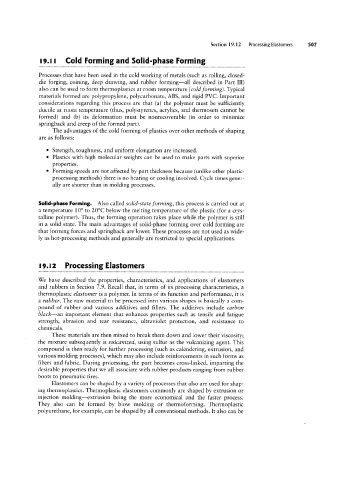Page 527 - 04. Subyek Engineering Materials - Manufacturing, Engineering and Technology SI 6th Edition - Serope Kalpakjian, Stephen Schmid (2009)
P. 527
Section 19.12 Processing Elastomers 50
Cold Forming and Solid-phase Forming
l9.l I
Processes that have been used in the cold working of metals (such as rolling, closed-
die forging, coining, deep drawing, and rubber forming-all described in Part III)
also can be used to form thermoplastics at room temperature (cold forming). Typical
materials formed are polypropylene, polycarbonate, ABS, and rigid PVC. Important
considerations regarding this process are that (a) the polymer must be sufficiently
ductile at room temperature (thus, polystyrenes, acrylics, and thermosets cannot be
formed) and (b) its deformation must be nonrecoverable (in order to minimize
springback and creep of the formed part).
The advantages of the cold forming of plastics over other methods of shaping
are as follows:
° Strength, toughness, and uniform elongation are increased.
° Plastics with high molecular weights can be used to make parts with superior
properties.
° Forming speeds are not affected by part thickness because (unlike other plastic-
processing methods) there is no heating or cooling involved. Cycle times gener-
ally are shorter than in molding processes.
Solid-phase Forming. Also called solid-state forming, this process is carried out at
a temperature 10° to 20°C below the melting temperature of the plastic (for a crys-
talline polymer). Thus, the forming operation takes place while the polymer is still
in a solid state. The main advantages of solid-phase forming over cold forming are
that forming forces and springback are lower. These processes are not used as wide-
ly as hot-processing methods and generally are restricted to special applications.
l9.l2 Processing Elastomers
We have described the properties, characteristics, and applications of elastomers
and rubbers in Section 7.9. Recall that, in terms of its processing characteristics, a
thermoplastic elastomer is a polymer. In terms of its function and performance, it is
a rubber. The raw material to be processed into various shapes is basically a com-
pound of rubber and various additives and fillers. The additives include carbon
black-an important element that enhances properties such as tensile and fatigue
strength, abrasion and tear resistance, ultraviolet protection, and resistance to
chemicals.
These materials are then mixed to break them down and lower their viscosity;
the mixture subsequently is vulcanized, using sulfur as the vulcanizing agent. This
compound is then ready for further processing (such as calendering, extrusion, and
various molding processes), which may also include reinforcements in such forms as
fibers and fabric. During processing, the part becomes cross-linked, imparting the
desirable properties that we all associate with rubber products ranging from rubber
boots to pneumatic tires.
Elastomers can be shaped by a variety of processes that also are used for shap-
ing thermoplastics. Thermoplastic elastomers commonly are shaped by extrusion or
injection molding-extrusion being the more economical and the faster process.
They also can be formed by blow molding or thermoforming. Thermoplastic
polyurethane, for example, can be shaped by all conventional methods. It also can be

